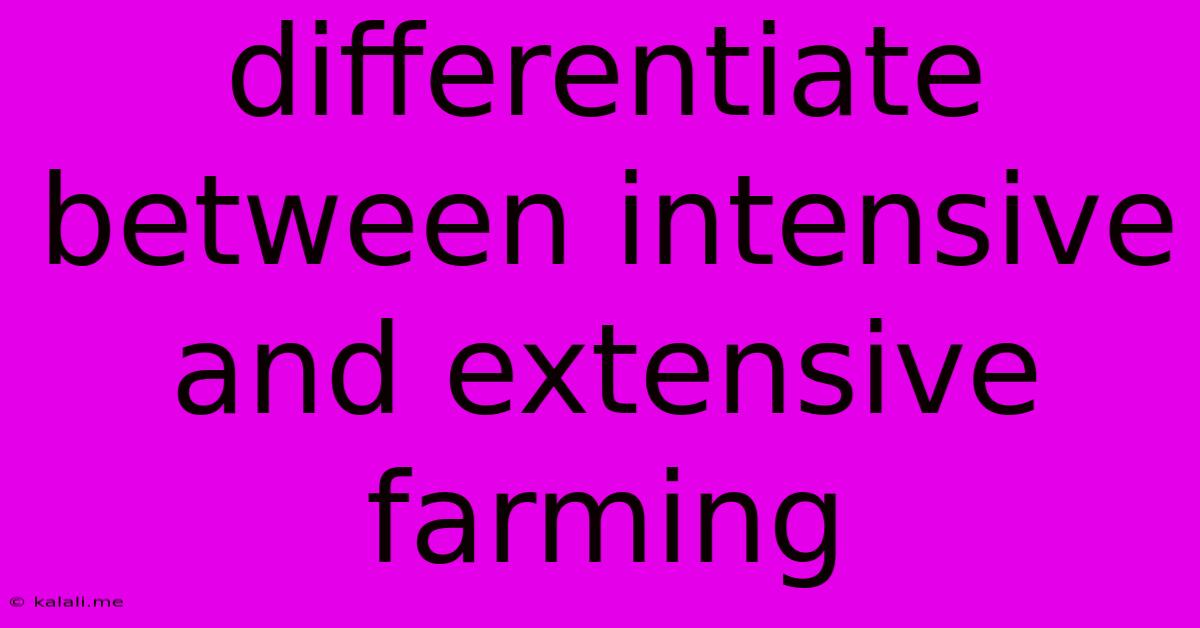Differentiate Between Intensive And Extensive Farming
Kalali
Jun 13, 2025 · 3 min read

Table of Contents
Intensive vs. Extensive Farming: A Comprehensive Comparison
Understanding the difference between intensive and extensive farming is crucial for anyone interested in agriculture, food security, or environmental sustainability. While both methods aim to produce food, they differ significantly in their approaches, resource utilization, and environmental impact. This article will delve into the key distinctions between these two farming systems, exploring their advantages and disadvantages.
What is Intensive Farming?
Intensive farming prioritizes maximizing yields from a relatively small area of land. This approach typically involves high inputs of labor, capital, and resources, such as fertilizers, pesticides, and irrigation. The goal is to achieve high production per unit area, often focusing on a single, high-value crop or livestock.
Key Characteristics of Intensive Farming:
- High yields per unit area: This is the primary goal, often achieved through advanced technologies and high resource inputs.
- High capital investment: Requires significant investment in machinery, technology, and infrastructure.
- High labor inputs: Often involves a high density of labor, especially in specialized operations like hydroponics or greenhouse farming.
- High use of chemical inputs: Frequently utilizes fertilizers, pesticides, and herbicides to boost yields and control pests and diseases.
- Specialized crops/livestock: Usually focuses on a limited range of high-value products optimized for the system.
- Potential for monoculture: This can lead to increased vulnerability to pests and diseases.
Examples of Intensive Farming:
- Factory farming: High-density animal production in confined spaces.
- Greenhouse farming: Controlled environments optimize plant growth with artificial lighting, temperature control, and nutrient solutions.
- Hydroponics and aquaponics: Soil-less cultivation methods that increase efficiency and yield.
- High-yield crop production: Using advanced techniques like precision agriculture and genetic modification to maximize yields.
What is Extensive Farming?
Extensive farming, conversely, utilizes large areas of land with relatively low inputs of labor, capital, and resources. It often relies on natural processes, such as rainfall for irrigation and natural pest control methods. Yields per unit area are typically lower compared to intensive farming, but overall production can still be substantial due to the large land area used.
Key Characteristics of Extensive Farming:
- Low yields per unit area: Compared to intensive farming, output per acre is generally lower.
- Low capital investment: Requires less investment in machinery and technology.
- Low labor inputs: Relatively low labor requirements per unit area.
- Low use of chemical inputs: Minimizes the use of synthetic fertilizers, pesticides, and herbicides.
- Diverse crops/livestock: Often includes a variety of crops and livestock, promoting biodiversity.
- More reliance on natural processes: Depends heavily on natural resources like rainfall and natural pest control.
Examples of Extensive Farming:
- Pastoral farming (ranching): Raising livestock over large grazing areas.
- Shifting cultivation: A traditional method involving clearing forests for temporary cultivation.
- Traditional subsistence farming: Producing enough food to meet the needs of the farmer's family.
Intensive vs. Extensive Farming: A Comparison Table
| Feature | Intensive Farming | Extensive Farming |
|---|---|---|
| Land use | Small area, high density | Large area, low density |
| Labor | High | Low |
| Capital | High | Low |
| Yield per unit | High | Low |
| Resource use | High (fertilizers, pesticides) | Low (relies on natural processes) |
| Environmental Impact | Potentially high (pollution) | Potentially lower (depending on scale) |
| Biodiversity | Low | Potentially high |
Conclusion:
Choosing between intensive and extensive farming methods depends on various factors, including available resources, market demand, environmental considerations, and social impacts. Both approaches have their advantages and disadvantages, and the optimal choice varies greatly depending on the specific context. A balanced approach, incorporating elements of both intensive and extensive practices where appropriate, may offer the most sustainable and efficient way to meet future food demands.
Latest Posts
Latest Posts
-
Does Hawaii Pacific University Require Sat
Jun 14, 2025
-
Which Of The Following Is The Inverse Of
Jun 14, 2025
-
How To Find Midpoint Of Triangle
Jun 14, 2025
-
Which Of The Following Is Not A Long Term Storage Device
Jun 14, 2025
-
Cutoff Frequency Of High Pass Filter Formula
Jun 14, 2025
Related Post
Thank you for visiting our website which covers about Differentiate Between Intensive And Extensive Farming . We hope the information provided has been useful to you. Feel free to contact us if you have any questions or need further assistance. See you next time and don't miss to bookmark.